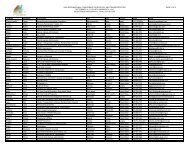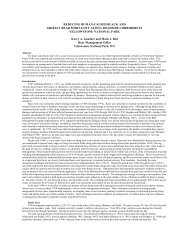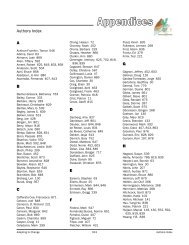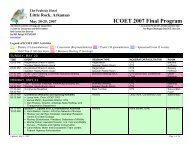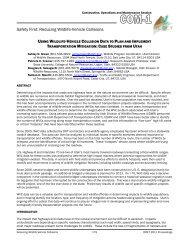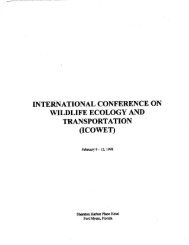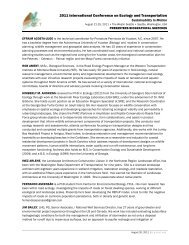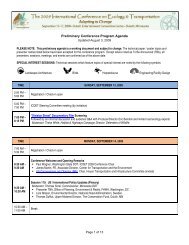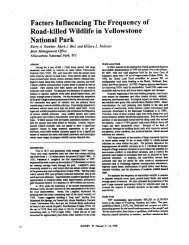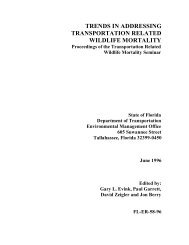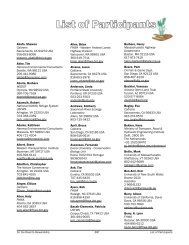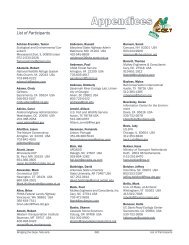Poster Sessions, pages 567-640 - ICOET
Poster Sessions, pages 567-640 - ICOET
Poster Sessions, pages 567-640 - ICOET
You also want an ePaper? Increase the reach of your titles
YUMPU automatically turns print PDFs into web optimized ePapers that Google loves.
Abstract<br />
Freshwater Mussel (Mollusca: Unionidae) Habitat Variability and Movement Patterns Following<br />
Relocation: A Case Study of Potamilus Capax (Green 1832)<br />
David R. Baldridge (417-252-0614, david.baldridge@smail.astate.edu) and Alan D. Christian,<br />
Department of Biological Sciences, Arkansas State University, P.O. Box 1054, State University, AR<br />
72467 USA<br />
Andrew J. Peck (870-243-0095, andrew.peck@smail.astate.edu), Department of Environmental<br />
Science, Arkansas State University, 3009 A Fairview Drive, Jonesboro, AR 72401 USA<br />
Relocation of freshwater mussel aggregates has been used as a mitigation strategy for nearly 30 years. Methodologies<br />
for relocation have been studied showing that identification of appropriate habitat characteristics are among the most<br />
important aspects when selecting a viable relocation site. Though relocation methodologies have been studied, little<br />
is known about the influence on behavioral patterns following relocation. This project is aimed at addressing information<br />
gaps regarding post-relocation monitoring activities which will be incorporated into the biological assessment of a<br />
proposed permit streamlining initiative between the US Fish and Wildlife Service, Federal Highway Administration, and<br />
Arkansas Transportation and Highway Department.<br />
The focus of this initiative is the fat pocketbook, Potamilus capax (Mollusca: Unionidae), which was designated as<br />
“Endangered” in June 1976 by the USFWS in the entire range of the species. The present general distribution of P.<br />
capax has been reported from the upper Mississippi River on the borders of Minnesota, Wisconsin, Iowa, Illinois, and<br />
Missouri, the Ohio River System on the borders of Indiana, Illinois, and Kentucky, especially its tributary the Wabash<br />
River in Indiana and Illinois, the White River of Missouri and Arkansas, and the St. Francis River system in Arkansas.<br />
These systems typify mid-western Mississippi River drainages with areas of slow moving water and substrate ranging<br />
from shifting sand and gravel to sand, silt, and clay substrates, suitable habitat for P. capax. This species is further<br />
characterized as being a long-term breeder with fertilization occurring in spring and gravid females present from June<br />
to October and uses the freshwater drum (Aplodinotus grunnies) as its host. Though P. capax was at one time present<br />
in many of these systems, historical accounts indicate that it was never a predominate species within the assemblage.<br />
Though mussels, in general are considered relatively stationary, many species, including P. capax, have adopted a<br />
mobility trait which may yield inaccurate monitoring results.<br />
The objectives of this study are to 1) analyze seasonal movement patterns of resident and relocated individuals and 2)<br />
relate movement to sediment characteristics at the relocation site. We hypothesize that relocated P. capax will show a<br />
greater displacement than resident P. capax. We also expect this displacement to be associated with habitat selection<br />
and/or reproduction. We have examined movement patterns of resident and relocated P. capax within an agricultural<br />
drainage system of the Saint Francis River system of Arkansas and Missouri. Two treatment groups have been monitored<br />
with different monitoring intervals. The first group was fitted with radio transmitters and was monitored at a<br />
maximum of one month intervals from October, 2005 to January, 2006 and July, 2006 to November, 2006 using radio<br />
telemetry. The second treatment group was monitored using mark and recapture (shell etch) techniques and positions<br />
recorded once quarterly from May, 2005 through March, 2007. Substrate composition (sand, silt, and clay), water<br />
depth, and water velocity were determined using 65 meter bank to bank transects at 10 meter intervals for the length<br />
of the 200 meter relocation reach. Substrate, depth and velocity were interpolated using krieging and spatial data<br />
analysis in GIS.<br />
Initial movement results of the quarterly sampling show native individuals (n = 41) with a displacement range between<br />
0.88 m and 151.92 m while relocated animals (n = 13) have displacement range between 3.44 m and 18.87 m. At the<br />
alpha = 0.10, this difference is significant (p = 0.09). Data for the transmitter treatment group are still being collected,<br />
but preliminary indications from the October, 2005, to January, 2006, monitoring period contradict this trend. In this<br />
time period, resident individuals (n = 11) had a range of total displacement from 0.60 m to 9.12 m while relocated<br />
individuals (n = 10) had a range of total displacement from 2.67 m to 14.90 m with a significantly greater average<br />
range as well (p



